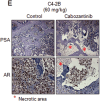Prostate Cancer: A Review of Genetics, Current Biomarkers and Personalised Treatments
- PMID: 39410867
- PMCID: PMC11480670
- DOI: 10.1002/cnr2.70016
Prostate Cancer: A Review of Genetics, Current Biomarkers and Personalised Treatments
Abstract
Background: Prostate cancer is the second leading cause of cancer deaths in men, second only to lung cancer. Despite this, diagnosis and prognosis methods remain limited, with effective treatments being few and far between. Traditionally, prostate cancer is initially tested for through a prostate serum antigen (PSA) test and a digital rectum examination (DRE), followed by confirmation through an invasive prostate biopsy. The DRE and biopsy are uncomfortable for the patient, so less invasive, accurate diagnostic tools are needed. Current diagnostic tools, along with genes that hold possible biomarker uses in diagnosis, prognosis and indications for personalised treatment plans, were reviewed in this article.
Recent findings: Several genes from multiple families have been identified as possible biomarkers for disease, including those from the MYC and ETS families, as well as several tumour suppressor genes, Androgen Receptor signalling genes and DNA repair genes. There have also been advances in diagnostic tools, including MRI-targeted and liquid biopsies. Several personalised treatments have been developed over the years, including those that target metabolism-driven prostate cancer or those that target inflammation-driven cancer.
Conclusion: Several advances have been made in prostate cancer diagnosis and treatment, but the disease still grows year by year, leading to more and more deaths annually. This calls for even more research into this disease, allowing for better diagnosis and treatment methods and a better chance of patient survival.
Keywords: biomarkers; genes; personalised treatment; prostate cancer.
© 2024 The Author(s). Cancer Reports published by Wiley Periodicals LLC.
Conflict of interest statement
The authors declare no conflicts of interest.
Figures

















References
-
- Giona S., “The Epidemiology of Prostate Cancer,” in Prostate Cancer, eds. Simon M., Bott R. J., and Ng M. K. L. (Brisbane, Australia: Exon Publications, 2021), 1–16. - PubMed
-
- Duffy M. J., “Biomarkers for Prostate Cancer: Prostate‐Specific Antigen and Beyond,” Clinical Chemistry and Laboratory Medicine (CCLM) 58, no. 3 (2020): 326–339. - PubMed
Publication types
MeSH terms
Substances
LinkOut - more resources
Full Text Sources
Medical
Research Materials
Miscellaneous

